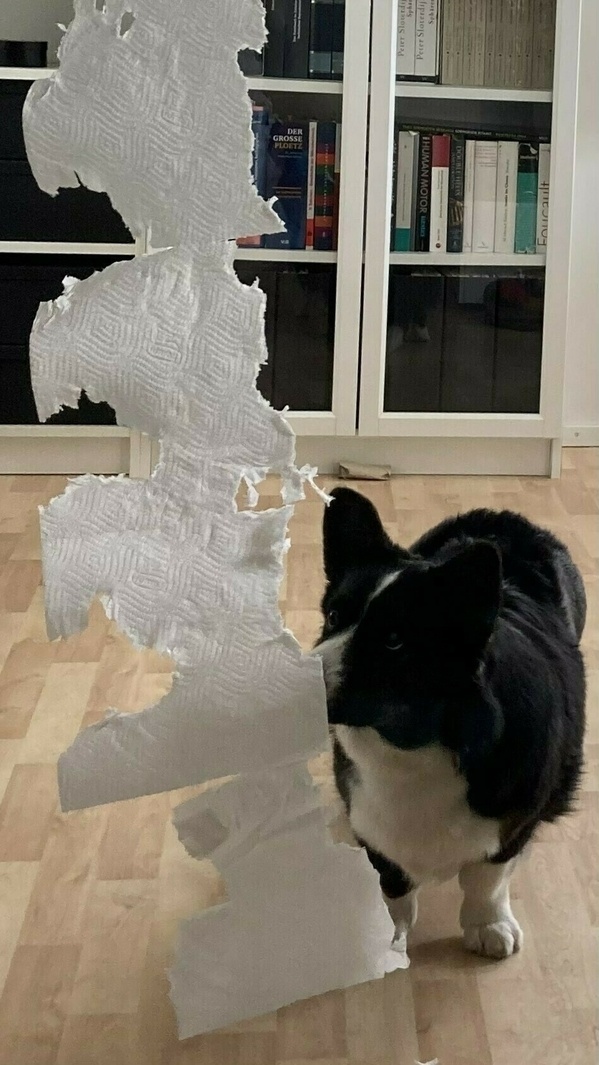DailyDogo 573 🐶

DailyDogo 573 🐶

I wonder if the dystopian looks of AR/VR headsets are really the problem. I can see that they don’t translate well to PR story telling: People find it creepy to look at.
But I do wonder if that even matters. If we think about people’s desktop setups right now - with multiple displays, the users hunched over a keyboard, cables everywhere, big headphones cutting us off, probably looking at a wall, instead of the room - isn’t this just as dystopian? What the current aesthetics of every day computing has going for itself in comparison to a headset blocking our view of the real(?) world is that you can make it look somewhat palatable in photos and videos.
If you hide the cables and clean the desk, it can be made to look somewhat pleasing even. But that’s not really how most computing places look.
In practice there are finger prints, bread crumbs, cables not very well hidden, there is fan noise, dust, asymmetry. And then we sit in front of these machines for hours on end. Computers brake our bodies. There is nothing innocent about using “normal” computers today. This is true also for handheld devices.
It seems to me that there are two directions to answer to this status quo. The first is a kind of digital ludditism: “We should use less screens, we should go out, we should not be so dependent and addicted to our computing devices.” The second is an optimistic affirmation of technological progress: “All the computing around us is great, the future is bright. I’m excited.” And then there are mixed versions: “Computers are great in moderation.” Or: “Computers are a necessary evil.”
I’ll add to the mix a stance that is all too often called fatalism: Computers are inevitable. And furthermore: There is no choice involved. It doesn’t really matter if we like or dislike technology. What matters is if technology is able to reorganize society around itself sufficiently. If a technology - take the smartphone - is able to do so, we’ll find all kinds of excuses - that’s the wrong word, because there is no value judgement implied, but merely a description of a general discourse dynamic - to not find it creepy or dystopian. In practice the reorganization has more to do with making certain kinds of activities more interesting, effective, productive - or, in short: more likely. If an activity sufficiently occurs mediated by a new technology - for whatever reason - that new technology will be adopted.
And when it has been sufficiently adopted, perceived PR problems are none anymore. But let’s not kid ourselves that it would be PR that makes this possible. PR can - maybe! - help to establish some use cases or open the door, but it’s the actual use that leads to an uptake in the likelihood of (mediated) activities. And that’s where the difference lies. That in turn doesn’t mean that PR is useless either. PR makes things appear pleasant, which is nice.
Coming back to AR/VR headsets: The problem of these technologies so far is that they do not make you play more games or take more meetings, or whatever. The technology is not persuasive enough to get over the uncanny valley. But, again, it’s not the uncanny valley itself that make them unsuccessful so far.
About the Vision Pro: I don’t think I would ever pay that much for a device. Except if I would be using it to make money myself.
I do wonder if it’ll matter, that people don’t like how the new Apple Headset looks. That it’s creepy and dystopian looking. It’s interesting to me that it’s the aesthetics and the way you look for others while wearing the thing.
DailyDogo 573 🐶

DailyDogo 572 🐶

DailyDogo 571 🐶

God damnit, Karelian pies are so good! 🇫🇮
Some ways in which notes can help to reach goals:
Some ways in which some types of notes can make you write more notes:
I think that one trick to make note taking make sense is to arrange your note taking in a way that leads to more note taking and then to make that note taking about reaching your goals. I say “and then” but both things (which are goals in themselves) have to be front and center all the time.
Quick note on the terrible, terrible reddit api pricing and how it affects apps like Apollo.
I’ll admit that my reddit usage has been barely existent in the last few years, but the last time I used reddit, I used it through the excellent app Apollo.
Apart from being upset by the sheer audacity and the way in which this was communicated, I always hope in moments like this, that we would move on collectively to more federated, less monopolistic ways of organizing ourselves online.
It would need large-scale adoption of paying by users - surely not 100%, but more than the 5% you hear often - for such a thing to occur, I think. People who are less technically inclined and maybe have less of an interest - ideological, anthropological or otherwise - would need to be part of this. I’m not very hopeful that they ever will.
There is a certain kind of perverse satisfaction to observe how some of these giants of social media are failing right now. But I’m not optimistic enough that all or even a significant portion of the people will make the jump because of this. Platforms like Instagram and TikTok seem to continue to thrive.
But for me, right now, there is a lot to see and do in places like micro.blog and mastodon. I hope it stays that way and maybe, just maybe, there are enough interesting people on these platforms that the “normies” will come over (and stay), too. It seems like this would lead to a healthier, more democratic future.
DailyDogo 570 🐶

From the faq page of the mouse config tool “logi options+":
Why is it called Logi Options+? Do I have to pay for it?
The ‘+’ stands for better design and user experience, with more features available over time. The app is free to use.
Always good if you have to explain that the new app is better designed and has an improved user experience, because it’s not obvious to the user wtf the name even stands for…
P.S.: Just to be clear: This app is a piece of garbage and breaks frequently.
Quick note about Obsidian’s new icon:
For me it’s more of a warning sign than reason to celebrate. The only time I want to see a rebrand is if the old brand was offensive. The Cleveland Indians/Guardians rebrand comes to mind. Otherwise I do not care directly.
I do care however about the meaning behind a rebrand. It seems the public facing reason is “the new icon represents our values” which is not inspiring confidence. It sounds too business-y, even if the values themselves sound good.
The old logo was licensed cc-by - so maybe they didn’t like that and changing the logo had mostly practical reasons and then they took the opportunity to strengthened their visual identity. Who knows really? But I take a rebrand as an indicator of “corporatification”: Grown ups (managers) showed up in the beautiful workshop that built Obsidian and needed to reduce the complexity of an ongoing project like this down to its perceived core, forgetting as always that illegibility is a non-debatable fact of reality. Reducing complexity is changing what you found, not stripping away inessential parts. We’ll see if they can hang.
In short: The best case scenario is that nothing will change. Dynalist inc. (the company behind Obsidian) will continue to make a great app and that’s it. Worst case scenario: There will be changes in the approach and the business practices to satisfy things like “growth” and “revenue”. Ugh. Let’s hope this is not an early indicator of Obsidian being the next Evernote…
P.S: 1Password rebranded recently, too. Shortly after they also added telemetry.
Quick note about the recent discussion about pricing of apps on @atpfm@mastodon.social:
I agree with almost everything that has been said by the hosts as regards to subscription pricing vs. “lifetime unlock”. It’s very obvious that it’s a better model for developers. However I think it’s important to point out, that it would not be - at least not immediately - in the best interest of potential customers to agree. Saving money is always great. Not having to worry about stuff like canceling subscriptions is always great. Psychology matters. Even if there is a second order argument to be made about the benefits of subscriptions for customers: Loss aversion is a real thing.
Related: Marco’s very old blog post Right versus pragmatic.
P.S.: I’m trying to get myself blogging again by doing some more posts in this style: Short comments or observations without lots of explanation and context. Let’s see how that goes.
DailyDogo 569 🐶

DailyDogo 568 🐶

DailyDogo 567 🐶

DailyDogo 566 🐶

DailyDogo 565 🐶

DailyDogo 564 🐶

DailyDogo 563 🐶

DailyDogo 562 🐶

DailyDogo 561 🐶

DailyDogo 560 🐶

DailyDogo 559 🐶
